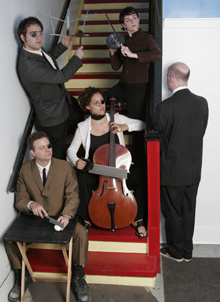
The Neo-Futurists prepare to give audiences a chance to explore a fascinating 1960's anti-art movement in Mr. Fluxus, conceived and directed by Greg Allen, opening Saturday, November 3 at 7:30 p.m. at The Neo-Futurarium, 5153 N. Ashland.
Enter. Climb. Listen. Hammer. Saw. Compose. Twist. Mail. Spy into. Squeeze out of. Neo-Futurists Founder Greg Allen’s latest endeavor embodies the life, work, spirit and ideas of Fluxus, an artistic 'non-movement' that began in the late 1950’s and greatly influenced Neo-Futurism. Original Fluxus pieces ranged from artists’ nailing down the keys of a piano to Yoko Ono’s inviting her audience to cut away her clothing. Allen’s piece is part environmental exhibit and part interactive performance -- audiences enter in small groups (up to fifteen people enter the space every fifteen minutes) to explore installations in all thirteen rooms of The Neo-Futurarium.
George Maciunas, who coined the term Fluxus, once said, “Art… must be simple, amusing, unpretentious, concerned with insignificance, require no skill or countless rehearsals, have no commodity or institutional value.” As Greg Allen puts it, “Fluxus was very much a revolutionary call for everyday people to perceive their lives as artistic. This has long been a goal of The Neo-Futurists.”
Greg Allen (director, performer) is the Founding Director and award-winning creator of over 25 productions for The Neo-Futurists, including Too Much Light Makes The Baby Go Blind, The Last Two Minutes of the Complete Works of Henrik Ibsen, Boxing Joseph Cornell, H2O, evidence, and K. His play The Complete Lost Works of Samuel Beckett... ran as one of the "best plays of the decade" in the 2006 New York International Fringe Festival.
Q&A with creator Greg Allen
Why Fluxus?
Fluxus was very much a revolutionary call for everyday people to perceive their lives as artistic. This has long been a goal of The Neo-Futurists. Fluxus certainly aesthetically influenced my creation of Neo-Futurism, and this is my chance to pay homage to it in a very direct way. We are exploring the specific ideas and methods of Fluxus, as well as how to turn life into art and art into life.
You're calling this show both an 'interactive exhibit' and an 'environmental installation'. What exactly does that mean?
The performance ranges through the entire space, starting outside on the sidewalk and going through all thirteen rooms of The Neo-Futurarium. At times, people are let go to experience things individually, but they also have collective tasks to accomplish before they can move on. Each audience member – or rather, 'participant' -- receives an exhibit guide leading them from room to room and explaining what to expect in each one. Of course, since this is Fluxus, the guide is partially erroneous.
So the audience is directly involved in the experience?
The original Fluxus artists believed that half of their art was supplied by the audience, that without the audience's visceral, hands-on experience, the work itself was not complete. In some ways, Mr. Fluxus will be a step beyond what our audiences experience in [our long-running show] Too Much Light Makes The Baby Go Blind, because there is even less of a distinction between audience and performer: we have done away with the stage altogether.
How did you select the members of your artistic team?
Because of the nature of the piece, I was looking for something beyond a group of traditional actors. Instead, I wanted artists who would help to create a complete experience in the space. So, I included artists from different backgrounds: sculpture, music, puppetry, filmmaking, dance, etc. Fluxus emphasized 'intermedia' and so does this show. Rather than multi-media, where there are separate media onstage, Mr. Fluxus integrates these media. We also are using media that did not exist when Fluxus was originally created, namely the internet and video.
Why are you offering "Pay once, return as often as you like?" for this show?
Well, this piece varies greatly from performance to performance, due to the level of audience involvement. Because it is interactive, and because audiences enter in small, staggered groups, the event is largely informed by the people one experiences it with. In addition, we plan to shift the activities for the audience as we go through the run. They have various tasks to execute, riddles to answer, etc. So the concept for the admission is that you pay once, but come back as often as you like, and each time should be quite different.

 Follow Us On Twitter
Follow Us On Twitter